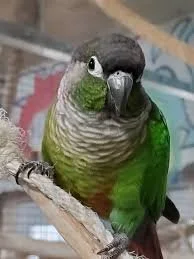Cherry-Headed Conure
Scientific Name: Psittacara erythrogenys
Habitat: Suptropical moist lowland forests, tropical forests, and gallery forests
Diet: Omnivore
Weight: 2.6-3.3 oz
Conservation Status: Near Threatened
Range: southwestern Ecuador and northwestern Peru
Lifespan: 20-30 Years
Size: 10.2-11 inches
The Cherry-headed Conure, also known as the Red-masked Parakeet, is a medium-sized parrot notable for its vivid coloration. Adults have a predominantly bright green body, but their most distinguishing feature is the bold red plumage covering the head, face, and upper chest. Some red feathers may also be scattered across the shoulders and thighs. Their tail is long and tapered, with blue and green tones, and their beak is pale horn-colored, adapted for cracking seeds and foraging. Their feet are zygodactyl (2 toes point forward one points backward), enabling strong grip and dexterity when climbing or handling food. Behaviorally, Cherry-headed Conures are social, active, and vocal birds, typically found in flocks in their native range. They are highly interactive, using loud calls to stay in contact with flock members and to warn of threats. These parrots are known for their playful behavior and strong pair bonds. During the breeding season—usually aligned with regional rainfall—they nest in natural tree cavities or sometimes use holes in cliffs or palms. The female lays 3 to 4 eggs and incubates them for about 23 to 26 days. After hatching, both parents participate in feeding the chicks, which fledge approximately 7 to 8 weeks later.
Green Cheeked Conure
Scientific Name: Pyrrhura molinae
Habitat: Humid and dry forests, gallery forests, woodlands, and chaco savanna edges
Diet: Omnivore
Weight: 2.1-2.8 oz
Conservation Status: Least concern
Range: South America, incl. Brazil, Bolivia, Paraguay, and northwestern Argentina
Lifespan: 10-30 Years
Size: 10 inches
The Green-cheeked Conure is a small parrot known for its compact size and colorful yet subtle feather coat. It has a primarily green body, with a greyish head and breast, blue flight feathers, and a maroon tail. The cheeks are tinged green, giving the bird its name, and its eyes are surrounded by white bare skin. Despite their modest size, they are known for their playful energy and expressive appearance. Behaviorally, Green-cheeked Conures are social, curious, and intelligent birds that thrive in flocks and form strong pair bonds. They are active foragers, feeding on fruits, seeds, berries, and blossoms, and communicate with soft, high-pitched calls—less raucous than many other conure species. Breeding typically occurs during the warmer, wetter months. They nest in tree cavities, where the female lays 4 to 6 eggs, incubated for about 22 to 25 days. Both parents participate in raising the chicks, which fledge at around 7 to 8 weeks of age.
Nanday Conure
Scientific Name: Aratinga nenday
Habitat: Pantanal Floodplains, open savanna landscapes
Diet: Herbivore
Weight: 4.2-4.9 oz
Conservation Status: Least Concern
Range: southeastern Bolivia, southwestern Brazil, central Paraguay, and northern Argentina
Lifespan: 20-45 Years
Size: 12-13 inches
Nanday Conures are medium-sized parrots recognizable by their striking black facial mask that contrasts sharply with their bright green plumage. Their bodies are mostly vibrant green with blue flight feathers and tail tips, while their belly and thighs often display a yellowish hue. These birds have a strong, curved beak that is well adapted for cracking seeds and nuts, and their zygodactyl feet (2 toes point forward one points backward) help them grasp branches and manipulate food. Their overall sleek and slender build, combined with their distinctive coloration, makes them easily identifiable among conure species. Nanday conures are highly social, intelligent, and vocal birds, often found in flocks in the wild where they engage in complex social interactions. They are known for their loud, raucous calls used to communicate within the flock and warn of potential threats. In captivity, nanday conures can become affectionate pets, capable of learning simple words and tricks. Breeding typically occurs during the spring and early summer months; they nest in tree cavities or similar sheltered spots. The female lays between 3 and 7 eggs, which she incubates for about 23 to 24 days. Both parents actively participate in feeding and caring for the hatchlings, which fledge roughly 7 to 9 weeks after hatching.


